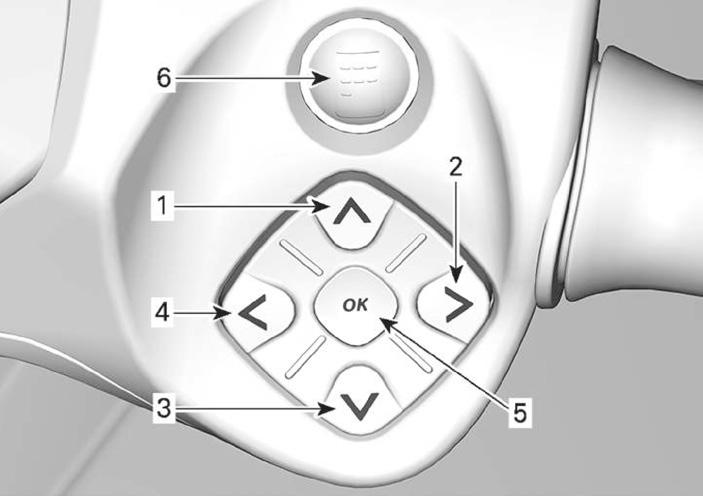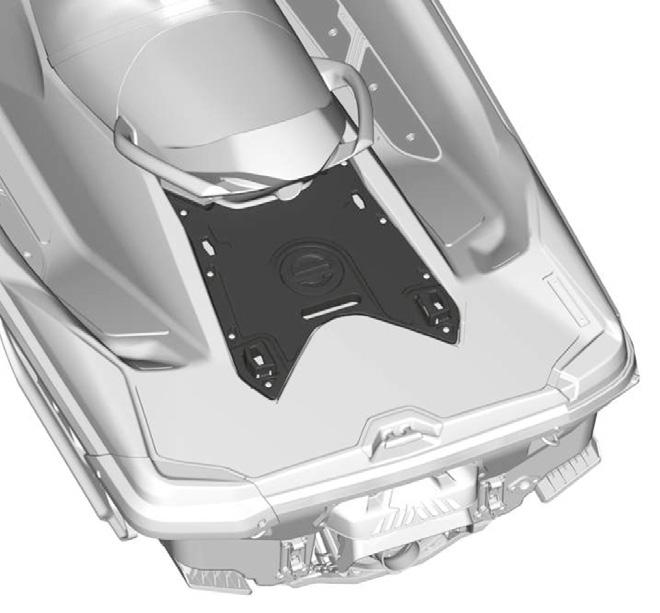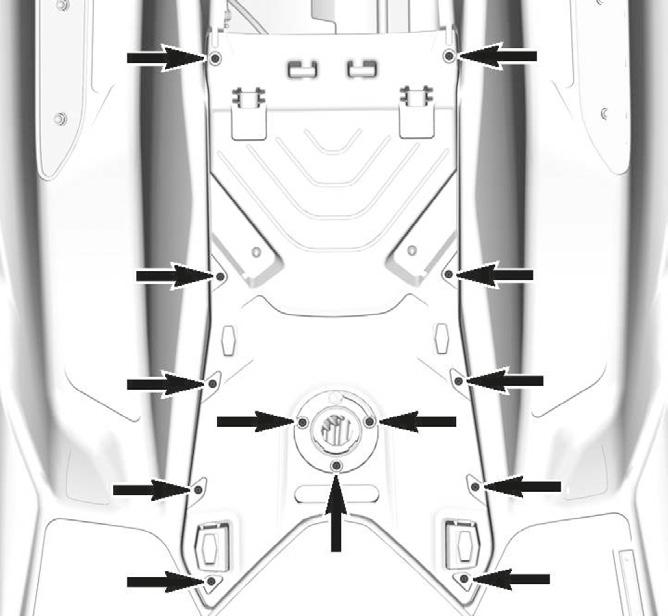1. Speed up
Thumbs up
2. Slow down
Thumbs down

1. Speed up
Thumbs up
2. Slow down
Thumbs down
5. Cut motor
Slashing hand across throat
6. OK after fall
Hands clasped over the head
3. Turn Circling motion above head followed by pointing in the directionof the turn
4. Back to shore
Pat top of head
7. Stop
Hand raised with fingers outstretched
8. All OK
An “0” made with the thumb and index finger
Messages in Multifunction Gauge
Important information about vehicle condition is displayed on the multifunction gauge. When starting the engine, always look at the gauge for any indicator lamps or special messages.
Use the right key for the vehicle or contact an authorized Sea-Doo dealer.
– Stop and wait for engine to cool off.
– Check for leaks.
– Check coolant level and adjust (see Maintenance Procedures).
Have the vehicle transported to the nearest authorized Sea-Doo dealer. If you operate the vehicle in LIMP HOME, avoid abrupt maneuvers. In LIMP HOME, the engine RPM is limited and therefore the vehicle speed.
– Check for oil leaks.
– Check oil level and adjust (see Mainte nance Procedures.


Indicator Lamps
Warning and Telltale Lights
Lights Description
ORANGE - Vehicle malfunction
RED - The engine temperature is too high.
GREEN - The neutral gear is selected
RED - If illuminate while driving, it indicates a malfunction. Turn off all unnecessary electrical equipment and have the electrical and charging systems checked.
RED - If illuminate while the engine running or while driving, this indicates a malfunction. Stop the vehicle as soon as it is safe to do so and turn the engine off. Check the engine oil level. Have the lubrication system checked a soon as possible, even if the level being correct.
ORANGE - Illuminate when the fuel level is low or when the fuel tank is near empty. Refuel as soon as possible.
ORANGE
Turned on: Malfunction of the vehicle emissions control system
Blink: Engine limitation, the limp home mode is activated. Have the vehicle serviced immediately.
When an item is selected, this sets the item to the current value.
Icons Description

Denote SPORT mode is selected.
Denote ECO mode is selected.
Denote SKI mode is selected (If equipped)
Indicate the direction of the vehicle. Not to be used for precision navigation purposes.
Flashing: indicate that the Launch Control is ready.
Steady ON: indicate that the VTS is activated.
When lit, indicates that a maintenance is required. See your authorized Sea-Doo dealer or person of your own choosing for the maintenance.
Denote Speed Limiter, Slow Speed or Ski mode is selected. (If equipped)
When lit, indicates a failure of the iBR system. See your authorized Sea-Doo dealer or person of your own choosing for repairing.
Denote WATER DEPTH mode is selected (If equipped)
Smartphone Network connection.
Bluetooth device.

Smartphone battery level indicator.


Fuel indicator
Temperature indicator
Speakers audio output

Menu Switches
RIGHT SIDE OF HANDLEBAR
1. UP button
2. RIGHT button
3. DOWN button
4. LEFT button

5. OK button
6. BRP CONNECT button
Use the directional buttons to control numerous functions of the multifunction gauge.
Use the BRP Connect button for quick access to BRP connect. Each click will swap between apps view and functions view of the multifunction gauge.
This section includes instructions for basic maintenance procedures.
Warning
Turn off the engine and follow these maintenance procedures when performing maintenance. If you do not follow proper maintenance procedures you can be injured by hot parts, moving parts, electricity, chemicals or other hazards.
Warning
Should removal of a locking device (e.g. lock tabs, self-locking fasteners, etc.) be required, always replace with a new one.
Notice
Never leave any object, rag, tool, etc., in the engine compartment or in the bilge.


TYPICAL
3. Remove the screws.
1. Remove the seats.
2. Remove the ski/ wake pylon cover.
TYPICAL
4. Remove the cover.
1. The installation is the reverse of the removal procedure. However, pay attention to the following.
2. Install all screws.
3. Tighten screws to specification.

Engine service cover screw 2.8 ± 0.2 Nm (25 ± 2 lbf-in)
Removing the Engine Service Cover Installing the Engine Service CoverWhenever your watercraft is used in salt or dirty water, this type of usage requires maintenance tasks to be performed between the regular yearly intervals. These are identified as A+ in the chart below.
If you regularly ride in salt or dirty water, follow the A+ interval and perform the tasks outlined in the chart below. Make sure to perform proper maintenance at recommended intervals as indicated in the tables.
The maintenance chart indicates the items needing to be addressed based on 2 criteria, whichever happens first:
• Calendar time
• Watercraft hours.
Your driving habits determines the factors you shall adhere to. For example:
• Someone who uses their vehicle every weekend would follow the hours reading to determine the frequency of his maintenance.
• Someone who uses their vehicle seldomly over the year or only on a few occasions would follow the calendar time to determine the frequency of his maintenance.
IMPORTANT: The following tables show the appropriate maintenance application for the first 3 years. For subsequent years, repeat the same pattern alternatively.
REGULAR SERVICE : A - First 6 months
SALT DIRTY WATER SERVICE : A+ - After each ride or monthly
Engine and cooling
• Engine oil
• A+ : Engine compartment
• A+ : Engine compartment metallic components
Change
Flush
Lubricate
REGULAR SERVICE : A - Every 12 months or 100 hours which ever comes first SALT DIRTY WATER SERVICE : A+ - After each ride or monthly
Air and fuel delivery
• Air delivery components and function (ducts, hoses, clamps)
• Fuel components and function (Fuel tank cap, fuel tank fixation, hose condition, leaks)*
• Super charger
Deck and hull
• Sacrificial anode(s)
• Body panels and hardware
• Hull
Engine and cooling
• Engine cooling components (coolant concentration, coolant level, hose condition, clamps, leaks)
• Engine oil and filter
• Ignition components and function
• Engine rubber mounts
• A+ : Engine compartment
• A+ : Engine compartment metallic components
Exhaust and emissions
• Exhaust components (gaskets, pipes, muffler condition, leaks)*
• Exhaust (For Salt or dirty water, flush after each ride)
iBR
• iBR components and function*
• iBR Rollers
Propulsion
• Propulsion components and function*
• Grease Driveshaft
Electrical
• Battery connections and condition*
• Electrical harness routing
• Modules and applicable software updates
• Operation of control switches and lighting
Steering and controls
• Steering components and function*
• Throttle operation
Feature
• Fish finder transducer support
Air and fuel delivery
• Air delivery components and function (ducts, hoses, clamps)
• Fuel components and function (Fuel tank cap, fuel tank fixation, hose condition, leaks)*
• Super charger
Deck and hull
• Sacrificial anode(s)
• Body panels and hardware
• Hull
Engine and cooling
• Engine cooling components (coolant concentration, coolant level, hose condition, clamps, leaks)
• Engine oil and filter
• Ignition components and function
• Engine rubber mounts
• Spark plugs
Exhaust and emissions
• Exhaust components (gaskets, pipes, muffler condition, leaks)*
• Exhaust
iBR
• iBR components and function*
• iBR Rollers
Propulsion
• Propulsion components and function*
• Grease Driveshaft
Electrical
• Battery connections and condition*
• Electrical harness routing
• Modules and applicable software updates
• Operation of control switches and lighting
Steering and controls
• Steering components and function*
• Throttle operation
Feature
• Fish finder transducer support
A - Every 36 months or 300 hours which ever comes first
Air and fuel delivery
• Air delivery components and function (ducts, hoses, clamps)
• Fuel components and function (Fuel tank cap, fuel tank fixation, hose condition, leaks)*
Deck and hull
• Sacrificial anode(s)
• Body panels and hardware
• Hull
Engine and cooling
• Engine cooling components (coolant concentration, coolant level, hose condition, clamps, leaks)
• Engine oil and filter
• Ignition components and function
• Engine rubber mounts
• Engine coolant
Exhaust and emissions
• Exhaust components (gaskets, pipes, muffler condition, leaks)*
• Exhaust
iBR
• iBR components and function*
• iBR Rollers
Propulsion
• Propulsion components and function*
• Grease Driveshaft
Electrical
• Battery connections and condition*
• Electrical harness routing
• Modules and applicable software updates
• Operation of control switches and lighting
Steering and controls
• Steering components and function*
• Throttle operation
Feature
• Fish finder transducer support
SERVICE : A + B - Every 48 months or 400 hours which ever comes first
Air and fuel delivery
• Air delivery components and function (ducts, hoses, clamps)
• Fuel components and function (Fuel tank cap, fuel tank fixation, hose condition, leaks)*
• Super charger
Deck and hull
• Sacrificial anode(s)
• Body panels and hardware
• Hull
Engine and cooling
• Engine cooling components (coolant concentration, coolant level, hose condition, clamps, leaks)
• Engine oil and filter
• Ignition components and function
• Engine rubber mounts
• Spark plugs
Exhaust and emissions
• Exhaust components (gaskets, pipes, muffler condition, leaks)*
• Exhaust
iBR
• iBR components and function*
• iBR Rollers
Propulsion
• Propulsion components and function*
• Grease Driveshaft
Electrical
• Battery connections and condition*
• Electrical harness routing
• Modules and applicable software updates
• Operation of control switches and lighting
Steering and controls
• Steering components and function*
• Throttle operation
Feature
• Fish finder transducer support
SERVICE :
A - Every Every 60 months or 500 hours which ever comes first
Air and fuel delivery
• Air delivery components and function (ducts, hoses, clamps)
• Fuel components and function (Fuel tank cap, fuel tank fixation, hose condition, leaks)*
Deck and hull
• Sacrificial anode(s)
• Body panels and hardware
• Hull
Engine and cooling
• Engine cooling components (coolant concentration, coolant level, hose condition, clamps, leaks)
• Engine oil and filter
• Ignition components and function
• Engine rubber mounts
• Engine coolant
Exhaust and emissions
• Exhaust components (gaskets, pipes, muffler condition, leaks)*
• Exhaust
iBR
• iBR components and function*
• iBR Rollers
Propulsion
• Propulsion components and function*
• Grease Driveshaft
Electrical
• Battery connections and condition*
• Electrical harness routing
• Modules and applicable software updates
• Operation of control switches and lighting
Steering and controls
• Steering components and function*
• Throttle operation
Feature
• Fish finder transducer support
©2023 Bombardier Recreational Products Inc., (BRP).
All rights reserved. ®, TM and the BRP logo are trademarks of Bombardier Recreational Products Inc. or its affiliates